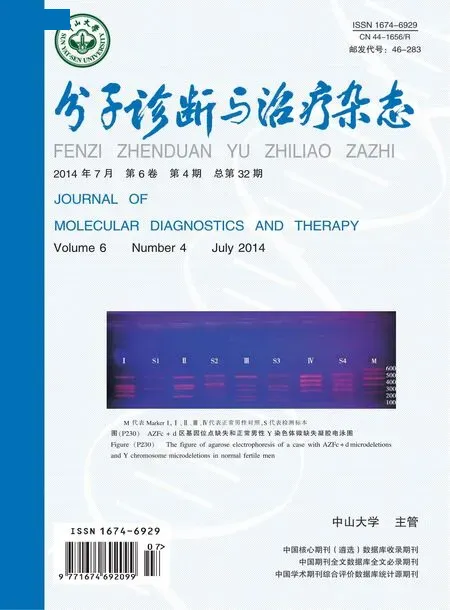与肺发育相关的microRNA
2014-04-18朱士博欧志英
朱士博 欧志英
·综述·
与肺发育相关的microRNA
朱士博 欧志英
microRNAs(miRNAs)是指一类短链非编码的RNA分子,起着负调控基因表达的作用。他们参与着重要的细胞生理生化过程,包括调控机体生长、发育、分化及代谢等。进一步了解miRNAs的作用及其机制,对疾病的诊断及治疗都可能提供一个新的方向。本文讨论与肺发育相关的miRNAs,将阐明microRNA在肺发育中的作用,为临床提供新的预防及治疗思路。
microRNA;肺发育;转录因子;生长因子
miRNAs是一类非编码的,进化保守的小RNA分子,它能调控基因的表达。从1993年发现的第一个miRNA(lin-4)到现在,已有很多miRNAs相继被发现,数量增长十分迅速。目前已有2 019个人类miRNAs被发现(Sanger miRBase version 18),他们的作用包括调控重要细胞生理过程,和不同疾病的发病机制[1]。
在最近的十几年里,通过蛋白组学和基因组学的研究,我们对肺部疾病的病理过程有了进一步的认识。这其中包括对病理生理,多个复杂的系统和众多启动子、转录因子的研究,大都进行了调控因子的研究,研究显示,miRNAs在肺的生长发育和肺部疾病中起着极其重要的作用[2_4]。
1 肺发育的分子基础
伴随着技术的进步,我们开始关注和研究肺发育中必须的关键“因子”。例如可以借助转基因技术,通过其过表达或敲除特定的基因,来评价肺发育的过程及其结局。
1.1转录因子
至少有两组转录因子在肺发育过程中发挥着重要作用,它们是:Nkx同源域(Nkx homeodomain),维甲酸信号通路(retinoid signaling pathway)。
1.1.1Nkx同源域转录因子
Nkx2.1是肺发育中最重要的同源域转录因子之一,也叫做TTF-1(甲状腺转录因子)。将Nkx2.1敲除的小鼠会影响气管食管的分离,以及早期肺的发育[5]。过量表达Nkx2.1后会导致出生后肺形态的改变,表现在肺泡Ⅱ型细胞增殖,肺泡发育不全。严重的会出现肺炎、肺纤维化、以及呼吸衰竭[6]。缺乏Nkx2.1基因的肺上皮细胞,不会表达标志蛋白,如Sp-B、Sp-C和CC10。在小鼠中Nkx2.1突变会导致其出生后死于肺泡畸形、肺发育不良,以及肺泡表面蛋白、血管内皮生长因子(VEGF)的表达减少[7]。
1.1.2维甲酸信号通路
最早的证据是1941年Andersen发现的维甲酸信号通路被干扰后发生了膈疝,原因是给大鼠喂食了缺乏维生素A的食物。于是运用现代分子遗传学技术基因敲除维甲酸受体(RAR),发现可以导致先天性膈疝,肺动脉高压以及肺发育不良[8]。在nitrofen诱导的先天性膈疝大鼠胎肺组织培养液中添加维甲酸,可以促进肺的生长,并部分改善了肺发育不良。当然有研究人员给nitrofen诱导的孕鼠喂食维生素A,发现可以促进肺的成熟和生长[9]。另外,喂食维生素A的仔鼠有更高的存活率。通过对比喂食维生素A的孕鼠和未处理组,发现喂食维生素A可以降低膈疝的发生率,由之前的54%降至32%[10]。最近,STRA6被证实是血清中维生素A的膜受体,将STRA6突变后导致小鼠先天性膈疝、肺动脉高压和一系列畸形[11]。
1.2多肽生长因子
1.2.1FGF家族
FGFR信号通路对早期肺分支的形成及发育是必需的。在孕14.5天时阻断FGFR信号,会导致产前气道形成减少,并且与产后严重的肺气肿关系密切。在孕16.5天阻断FGFR信号会引起中度肺气肿。缺乏FGFR3和FGFR4的小鼠无法形成正常的肺泡,表现在纤维细胞疏松,弹力蛋白过度表达[12]。
FGF10是肺发育中被研究最多的蛋白之一。敲除FGF10的小鼠会出现末梢肺发育障碍[13]。FGF10对邻近上皮细胞有趋化作用:在间质中上皮细胞的增殖和迁移都是朝向FGF10[14]。FGF10控制着上皮的分化,包括下调Sp-C和Bmp4的表达[15]。
1.2.2TGF-β亚家族
TGF-β配体亚家族包含3个亚型:TGF-β1、2和3。基因敲除TGF-β1后,小鼠在产后2月内因进行性肺炎死亡,可能是负向调节免疫系统的原因[16]。TGF-β2基因敲除的小鼠在孕14.5天因为肺发育不良和复杂心脏畸形而死亡[17]。TGF-β3敲除的小鼠出生后表现为肺发育迟缓,腭裂,严重的吞咽和呼吸困难[18]。而且阻断TGF-β通路后会导致严重的肺部畸形[19]。
1.2.3Wnt/β-catenin通路
Wnt信号在器官生长发育过程和肿瘤生长中发挥着重要作用[20]。在胎肺中敲除β-catenin会干扰气道上皮、间质和血管的正常发育。Wnt5a过表达能直接调节间质细胞中FGF10的表达[21],结合基因表达分析:β-catenin信号调节着间质细胞的发育,并且对正常内皮的分化是必需的[22]。Cohen等[23]证实Wnt信号对气管平滑肌的发育起着重要的作用。
1.2.4胰岛素样生长因子(IGFs)
IGF1缺乏的小鼠会出现气道缩小,Sp3,Sp-B表达下降[24]。IGF1对胎肺内皮细胞是有益的:在人类胎肺培养中,将IGF1R沉默会导致内皮细胞减少,气道分支减少,增加间质细胞的凋亡[25]。
2 miRNA对上述信号通路及生长因子的作用
近年来,随着研究的不断深入,发现一些microRNAs通过调控很多信号通路或生长因子来发挥重要的作用。Qi等发现在肺癌中miR-365通过3’-UTR来调控发育相关基因TTF-1[26]。miR-8,在果蝇中属于miR-200家族的成员,被证实具有负向调控Wnt信号通路的作用[27]。Nodal是TGF-β家族中的一种配体,在生长发育引导胚层以及身体轴向的分化。在爪蟾中研究发现miR-15、miR-16能减弱Nodal信号通路,原因是他们能够抑制Nodal受体激活素[28]。有学者在研究大鼠肝脏时发现miR-20a通过抑制TGF-β信号通路,抑制胚胎干细胞的分化,调节肝脏发育的过程[29]。Smad蛋白是一大类转录因子,他们能转导TGF-β信号通路,同样也受miRNAs的调控。在肝脏发育中,miR-23b这一簇被证实能够靶向调控三个SMAD(包括Smad3,Smad4和Smad5)。因此抑制miR-23b可以促进TGF-β信号的转导,使肝脏细胞增殖[30]。研究人员通过荧光素酶系统证实miR-146a的目标基因是Smad4,其通过TGF-β/Smad信号通路调节细胞分化[31]。Wang等将小鼠miR_126敲除,会出现血管瘘,大出血,不久便会死亡,原因是没有足够的内皮细胞去维持血管的完整性。其可以通过VEGF和FGF通路来促进血管再生[32]。Saito及其同事研究在A549肺腺癌细胞系中,miR-23a可以部分调节TGF-β和TNF-α通路,以此来调控上皮-间质的转化[33]。还有研究显示在急性肺损伤中miR-16调节肺皮中钠通道的表达,其可以抑制TGF-β,其目标基因是羟色胺转运体(SERT)[34]。Woltering等在斑马鱼中研究发现miR-10能抑制HoxB1和HoxB3a[35]。Naguibneva及其同事证实miR-181通过靶基因Hox-a11来调节哺乳动物中肌细胞的分化过程[36]。有研究人员在研究罗非鱼时发现miR-206能够调节IGF-1基因的表达,以此来调控其生长发育[37]。Jia等在Hela细胞系中过表达miR-223,通过其靶基因IGF-1R能抑制细胞增殖[38]。
3 miRNAs在肺发育中的研究
有许多miRNAs显示和肺发育相关,让我们能更好的理解其肺发育不良的病理机制提供了基础。Bhaskaran等发现在孕晚期胎鼠的胎肺中高表达miRNA-127,原位杂交显示其在胎肺发育中,逐渐由间叶细胞转移至上皮细胞。于是在孕早期胎肺中过表达miRNA-127(miR-127),导致胎肺肺芽数量下降,肺芽体积大小不等,提示miR-127可能在胎肺发育中起着重要作用[39]。Ventura等在小鼠中将miR-17-92基因簇敲除后,发现其生后不久便死于严重肺发育不良和室间隔缺损[40]。Lu等通过腺病毒载体在小鼠胎肺中过表达miR-17-92簇,导致其发生表型异常,表现为原始的肺上皮细胞高度增殖,终末气腔缺失,这表明miR-17-92簇对肺发育至关重要,其在小鼠胎肺中表达量很高[41]。Wang等证实miR-375通过抑制Wnt信号通路调节大鼠肺泡上皮的分化[42]。miR-17,miR-20a和miR-106b直接调控Stat3和Mapk4,通过FGF10-FGFR2b的下调来调控E钙粘蛋白的表达。因此miR-17及其同源簇是调节FGF10-FGFR2b通路的关键信号之一,其调节着肺芽形态发生的周期规律[43]。Gradus等研究显示miR-125b和miR-30a/c通过FGF通路控制气管软骨的分化,其对气管的正常发育至关重要[44]。
4 总结以及未来的挑战
随着大量的miRNAs被证实和发现,每一个都有许多假定的目标基因,现在的挑战是去研究和验证他们的生物学功能,但是恰恰因为miRNAs和目标基因的作用,以及相互之间的精细调节而把该问题变得更加复杂。然而,回顾microRNA和肺发育的相互关系,会使我们分辨并筛选出更有价值和线索的microRNA继续研究。
未来的挑战将是系统地研究所有microRNA的功能,以及和细胞信号通路之间的关系,并从中挑选出与肺发育相关的miRNAs。对于miRNAs上游及下游的反馈调节,是否能有理想的方法来帮助我们观察这些信号通路的表达?很多时候不能只靠直觉和预测,而是需要科学的实验论证。这样将阐明microRNA在肺发育中的作用,为临床提供新的预防及治疗思路。
[1]Kozomara A,Griffiths-Jones S.miRBase:integrating microRNA annotation and deep-sequencing data[J].Nucleic Acids Res,2011,39:D152_157.
[2]Nana-Sinkam S P,Hunter M G,Nuovo G J,et al.Integrating the MicroRNome into the study of lung disease[J].Am J Reapir Crit Care Med,2009,179:4_ 10.
[3]Tomankova T,Petrek M,Kriegova E.Involvement of microRNAs in physiological and pathological processes in the lung[J].Respir Resv,2010,11:159.
[4]Pagdin T,Lavender P.MicroRNAs in lung diseases.Thorax,2012,67:183_184.
[5]Minoo P,Su G,Drum H,et al.Defects in tracheoesophageal and lung morphogenesis in Nkx2.1(_/_)mouse embryos[J].Dev Biol,1999,209:60_71.
[6]Wert S E,Dey C R,Blair P A,et al.Increased expression of thyroid transcription factor-1(TTF-1)in respiratory epithelial cells inhibits alveolarization and causes pulmonary inflammation[J].Dev Biol,2002,242: 75_87.
[7]De Felice M,Silberschmidt D,DiLauro R,et al.TTF-1phosphorylationisrequiredforperipheral lung morphogenesis,perinatal survival,and tissuespecific gene expression[J].J Biol Chem,2003,278: 35574_35583.
[8]Mendelsohn C,Lohnes D,Decimo D,et al.Function of the R-A receptors(RARs)during development(II).Multiple abnormalities at various stage of organogenesis in RAR double mutants[J].Development,1994,120: 2749_2771.
[9]Thebaud B,Barlier-Mur A M,Chailley-Heu B,et al.Restoringeffects of vitamin A on surfactant synthesis in nitrofen-induced congenitaldiaphragmatic hernia in rats [J].Am J Respir Crit Care Med,2001,164:1083_1089.
[10]Babiuk R P,Thebaud B,Greer J J.Reductions in the incidence of nitrofen-induced diaphragmatic hernia by vitamin A and retinoic acid[J].Am J Physiol Lung Cell Mol Physiol,2004,286:L970_L973.
[11]Golzio C,Martinovic-Bouriel J,Thomas S,et al.Matthew-Woodsyndromeiscausedbytruncating mutations in the retinol-binding protein receptor gene STRA6[J].Am J Hum Genet,2007,80:1179_1187.
[12]Hokuto I,Perl A K,Whitsett J A.Prenatal,but not postnatal,inhibition of fibroblast growth factor receptor signaling causes emphysema[J].J Biol Chem,2003, 278:415_421.
[13]Min H,Danilenko D M,Scully S A,et al.Fgf-10 is required for both limb and lung development and exhibitsstrikingfunctionalsimilaritytoDrosophila branchless[J].Genes Dev,1998,12:3156_3161.
[14]Weaver M,Dunn N R,Hogan B L.Bmp4 and Fgf10 play opposing roles during lung bud morphogenesis[J].Development,2000,127:2695_2704.
[15]Hyatt B A,Shangguan X,Shannon J M.BMP4 modulates fibroblast growth factor-mediated induction of proximal and distal lung differentiation in mouse embryonictrachealepitheliuminmesenchyme-free culture[J].Dev Dyn,2002,225:153_165.
[16]McLennan I S,Poussart Y,Koishi K.Development of skeletal muscles in transforming growth factor-beta 1 (TGF-beta1)null-mutant mice[J].Dev Dyn,2000,217: 250_256.
[17]Bartram U,Molin D G,Wisse L J,et al.Double-outlet right ventricle and overriding tricuspid valve reflect disturbances of looping,myocardialization,endocardial cushion differentiation,and apoptosis in TGF-beta(2)-knockout mice[J].Circulation,2001,103:2745_2752.
[18]Shi W,Heisterkamp N,Groffen J,et al.TGF-beta3-null mutation does not abrogate fetal lung maturation in vivo by glucocorticoids[J].Am J Physiol,1999,277: L1205_L13.
[19]Komatsu Y,Shibuya H,Takeda N,et al.Targeted disruption of the tab1 gene causes embryonic lethality and defects in cardiovascular and lung morphogenesis [J].Mech Dev,2002,119:239_249.
[20]Mucenski M L,Wert S E,Nation J M,Loudy DE,et al.Beta-cateninisrequiredforspecificationof proximal/distal cell fate during lung morphogenesis[J].J Biol Chem,2003,278(41):40231_40238.
[21]Li C,Hu L,Xiao J,et al.Wnt5a regulates Shh and Fgf10 signaling during lung development[J].Dev Biol, 2005,287(1):86_97.
[22]De Langhe S P,Carraro G,Tefft D,et al.Formation and differentiation of multiple mesenchymal lineages during lung development is regulated by beta-catenin signaling[J].PLoS One,2008,3(1):e1516.
[23]Cohen E D,Ihida-Stansbury K,Lu M M,et al.Wnt signaling regulates smooth muscle precursor development in the mouse lung via a tenascin C/PDGFR pathway[J].J Clin Invest,2009,119(9):2538_2549.
[24]Pichel J G,Fernandez-Moreno C,Vicario-Abejon C,et al.Developmental cooperation of leukemia inhibitory factor and insulin-like growth factor I in mice is tissuespecific and essential for lung maturation involving the transcription factors Sp3 and TTF-1[J].Mech Dev, 2003,120:349_361.
[25]Han R N,Post M,Tanswell A K,et al.Insulin-like growthfactor-Ireceptor-mediatedvasculogenesis/ angiogenesis in human lung development[J].Am J Respir Cell Mol Biol,2003,28:159_169.
[26]Qi J,Rice S J,Salzberg A C,et al.MIR-365 regulates lung cancer and developmental gene thyroid transcription factor 1[J].Cell Cycle,2012,11(1):177_186.
[27]Kennell J A,Gerin I,MacDougald O A,et al.The microRNA miR-8 is a conserved negative regulator of Wnt signaling[J].Proc Natl Acad Sci,2008,105: 15417_15422.
[28]Martello G,Zacchigna L,Inui M,et al.MicroRNA control of Nodal signalling[J].Nature,2007,449:183_ 188.
[29]Wei W,Hou J,Alder O,et al.Genome-wide microRNAandmRNAprofilinginmouseliver developmentimplicatesmir302bandmir20ain repressing TGF-β signaling[J].Hepatology,2013,12.doi:10.1002/hep.26252.[Epub ahead of print]
[30]Rogler C E,Levoci L,Ader T,et al.MicroRNA-23b cluster microRNAs regulate transforming growth factorβ/bone morphogenetic protein signaling and liver stem cell differentiation by targeting Smads[J].Hepatology, 2009,50:575_584.
[31]Zhong H,Wang H R,Yang S,et al.Targeting Smad4 links microRNA-146a to the TGF-beta pathway during retinoid acid induction in acute promyelocytic leukemia cell line[J].Int J Hematol,2010,92(1):129_135.
[32]Wang S,Aurora A B,Johnson B A,et al.The endothelial-specificmicroRNAmiR-126governs vascular integrity and angiogenesis[J].Dev Cell,2008, 15(2):261_271.
[33]Saito A,Suzuki H I,Horie M,et al.An integrated expression profiling reveals target genes of TGF-βand TNF_αpossibly mediated by microRNAs in lung cells [J].PLoS ONE,2013,8(2):e56587.
[34]Tamarapu P P,Galam L,Huynh B,et al.MicroRNA 16modulatesepithelialsodiumchannelinhuman alveolar epithelial cells[J].Biochem Biophys Res Commun,2012,426(2):203_208.
[35]Oltering J M,Durston A J.MIR-10 represses HoxB1a and HoxB3a in zebrafish[J].PLoS One,2008,3(1): e1396.
[36]Naguibneva I,Ameyar Z M,Polesskaya A,et al.The microRNA miR-181 targets the homeobox protein Hox-A11 during manmalian myoblast differentiation[J].Nat Cell Biol,2006,8(3):278_284.
[37]Yan B,Zhu C D,Guo J T,et al.miR-206 regulates the growth of the teleost tilapia through the modulation of IGF-1 gene expression[J].J Exp Biol,2013,216: 1265_1269.
[38]Jia C Y,Li H H,Zhu X C,et al.MIR-223 suppresses cell proliferation by targeting IGF-1R[J].PLoS One, 2011,6(11):e27008.
[39]Bhaskaran M,Wang Y,Zhang H,et al.MicroRNA-127 modulates fetal lung development[J].Physiol Genomics,2009,37(3):268_278.
[40]Ventura A,Young A G,Winslow M M,et al.Targeted deletion reveals essential and overlapping functions of the miR-17 through 92 family of miRNA clusters[J].Cell,2008,132(5):875_886.
[41]Lu Y,Thomson J M,Wong H Y,et al.Transgenic over-expression of the microRNA miR-17-92 cluster promotes proliferation and inhibits differentiation of lung epithelial progenitor cells[J].Dev Biol,2007,310 (2):442_453.
[42]Wang Y,Huang C,Reddy C N,et al.miR-375 regulates rat alveolar epithelial cell trans-differentiation by inhibiting Wnt/β-catenin pathway[J].Nucleic Acids Res,2013,41(6):3833_3844.
[43]Carraro G,El-Hashash A,Guidolin D,et al.MiR?17 familyofmicroRNAscontrolsFGF10-mediated embryoniclungepithelialbranchingmorphogenesis through MAPK14 and STAT3 regulation of E-cadherin distribution[J].Dev Biol,2009,333(2):238_250.
[44]Gradus B,Alon I,Hornstein E.miRNAs control tracheal chondrocyte differentiation[J].Dev Biol,2010, 360(1):58_65.
MicroRNAs and lung development
ZHU Shibo,OU Zhiying
(Guangzhou Women and Children’s medical center,Guangdong,Guangzhou 510623,China)
MicroRNA(miRNAs)are a kind of small non-coding RNA molecules that negatively regulate gene expression.They participate in the modulation of important cell physiological and biochemical processes such as the regulation of body growth,development,differentiation and metabolism.Studying more about the role of miRNAs and their mechanisms could lead us to realize the development of new diagnosis and treatment.This article discusses with lung development-related miRNAs and the possible future of these discoveries in clinical applications.
microRNA;Lung development;Transcript factor;Growth factor
广东省自然科学基金(S2012010009538)
广州市妇女儿童医疗中心,广东,广州510623
欧志英,E-mail:ou_zhiying@qq.com
